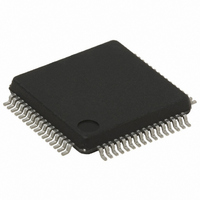ST72F321BR9T6 STMicroelectronics, ST72F321BR9T6 Datasheet - Page 34

ST72F321BR9T6
Manufacturer Part Number
ST72F321BR9T6
Description
MCU 8BIT 60KB FLASH/ROM 64-LQFP
Manufacturer
STMicroelectronics
Series
ST7r
Datasheet
1.ST72F321BK6T6.pdf
(187 pages)
Specifications of ST72F321BR9T6
Core Processor
ST7
Core Size
8-Bit
Speed
8MHz
Connectivity
I²C, SCI, SPI
Peripherals
LVD, POR, PWM, WDT
Number Of I /o
48
Program Memory Size
60KB (60K x 8)
Program Memory Type
FLASH
Ram Size
2K x 8
Voltage - Supply (vcc/vdd)
3.8 V ~ 5.5 V
Data Converters
A/D 16x10b
Oscillator Type
Internal
Operating Temperature
-40°C ~ 85°C
Package / Case
64-LQFP
Processor Series
ST72F3x
Core
ST7
Data Bus Width
8 bit
Data Ram Size
2 KB
Interface Type
I2C, SCI, SPI
Maximum Clock Frequency
8 MHz
Number Of Programmable I/os
48
Number Of Timers
2
Maximum Operating Temperature
+ 85 C
Mounting Style
SMD/SMT
Development Tools By Supplier
ST7232X-EVAL, ST7232X-SK/RAIS, ST72321B-D/RAIS, ST7MDT20-DVP3, STX-RLINK
Minimum Operating Temperature
- 40 C
On-chip Adc
10 bit, 16 Channel
Cpu Family
ST7
Device Core Size
8b
Frequency (max)
8MHz
Total Internal Ram Size
2KB
# I/os (max)
48
Number Of Timers - General Purpose
2
Operating Supply Voltage (typ)
5V
Operating Supply Voltage (max)
5.5V
Operating Supply Voltage (min)
3.8V
Instruction Set Architecture
CISC
Operating Temp Range
-40C to 85C
Operating Temperature Classification
Industrial
Mounting
Surface Mount
Pin Count
64
Package Type
LQFP
For Use With
497-5046 - KIT TOOL FOR ST7/UPSD/STR7 MCU
Lead Free Status / RoHS Status
Lead free / RoHS Compliant
Eeprom Size
-
Lead Free Status / Rohs Status
Details
Other names
497-5586
Available stocks
Company
Part Number
Manufacturer
Quantity
Price
Company:
Part Number:
ST72F321BR9T6
Manufacturer:
STMicroelectronics
Quantity:
10 000
ST72321BRx, ST72321BARx ST72321BJx, ST72321BKx
INTERRUPTS (Cont’d)
7.3 INTERRUPTS AND LOW POWER MODES
All interrupts allow the processor to exit the WAIT
low power mode. On the contrary, only external
and other specified interrupts allow the processor
to exit from the HALT modes (see column “Exit
from HALT” in “Interrupt Mapping” table). When
several pending interrupts are present while exit-
ing HALT mode, the first one serviced can only be
an interrupt with exit from HALT mode capability
and it is selected through the same decision proc-
ess shown in
Note: If an interrupt, that is not able to Exit from
HALT mode, is pending with the highest priority
when exiting HALT mode, this interrupt is serviced
after the first one serviced.
Figure 21. Concurrent Interrupt Management
Figure 22. Nested Interrupt Management
34/187
11 / 10
11 / 10
MAIN
MAIN
Figure
RIM
RIM
20.
IT2
IT2
IT1
IT1
IT4
TRAP
TRAP
IT1
IT4
IT0
IT0
7.4 CONCURRENT & NESTED MANAGEMENT
The following
different interrupt management modes. The first is
called concurrent mode and does not allow an in-
terrupt to be interrupted, unlike the nested mode in
Figure
in this order from the lowest to the highest: MAIN,
IT4, IT3, IT2, IT1, IT0, TLI. The software priority is
given for each interrupt.
Warning: A stack overflow may occur without no-
tifying the software of the failure.
IT3
IT3
IT1
22. The interrupt hardware priority is given
IT4
IT2
Figure 21
10
10
SOFTWARE
PRIORITY
LEVEL
SOFTWARE
PRIORITY
LEVEL
MAIN
MAIN
and
3
3
3
3
3
3
3/0
3
3
2
1
3
3
3/0
Figure 22
I1
I1
1 1
1 1
1 1
1 1
1 1
1 1
1 1
1 1
0 0
0 1
1 1
1 1
show two
I0
I0














